University Data Mining Report: AIH Financial Aid Project
VerifiedAdded on 2020/03/23
|11
|2538
|26
Report
AI Summary
This report provides a detailed analysis of a data mining project undertaken for AIH, focusing on its financial aid program for students. The report begins by outlining the business objectives, including increasing student enrollment and providing financial assistance. It assesses the resources available, such as personnel, data, and software tools like MATLAB, and identifies the sources of data and knowledge necessary for the project. The report then defines the project's requirements, assumptions, and constraints, including the six-month completion timeline, quality standards, and security and legal considerations. It also addresses various types of risks, such as business, organizational, financial, technical, and data risks, and proposes mitigation strategies. Finally, the report establishes data mining goals, translating business questions into technical objectives to ensure the project's success in achieving its financial and educational goals. The report emphasizes the importance of financial management, product management, and student success in determining the overall success of the AIH project.
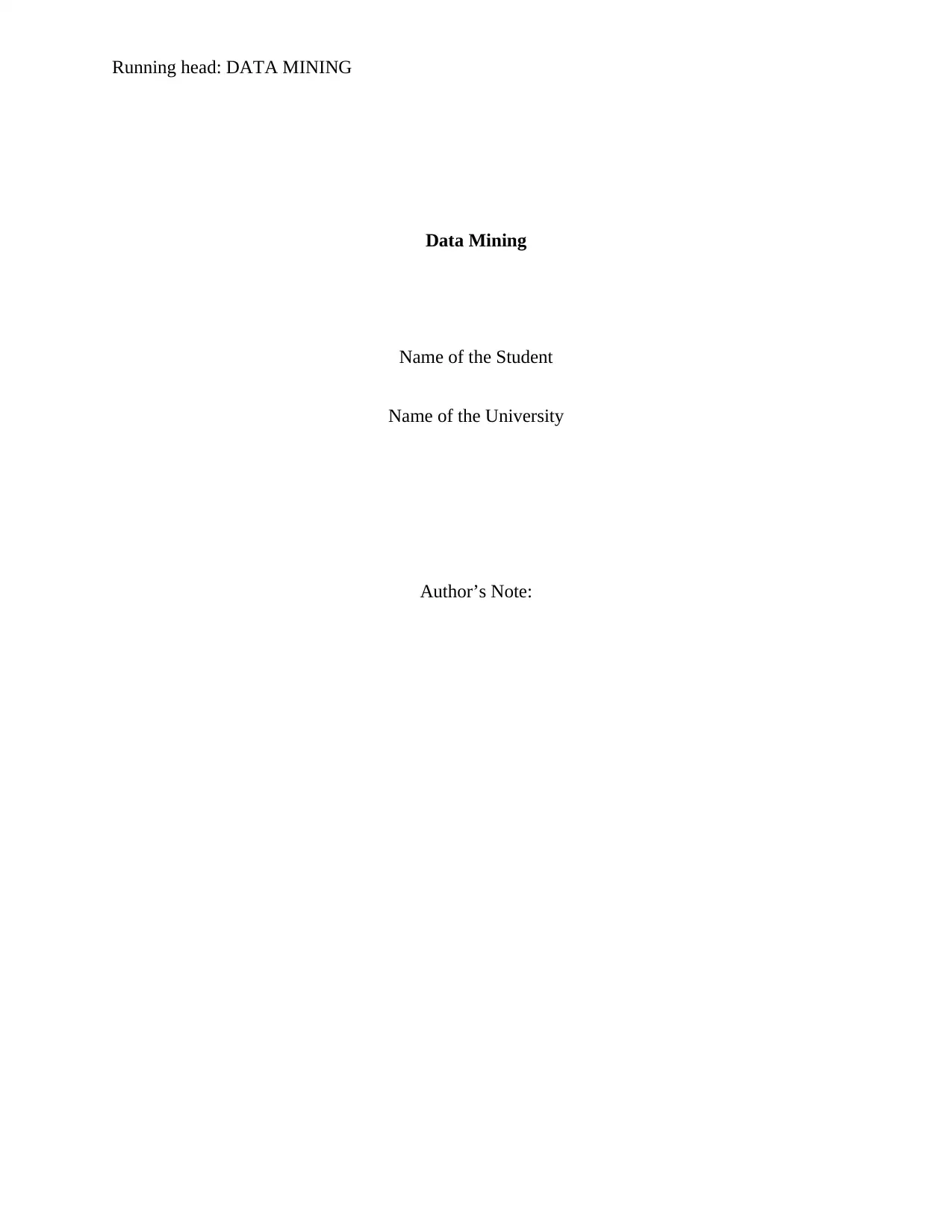
Running head: DATA MINING
Data Mining
Name of the Student
Name of the University
Author’s Note:
Data Mining
Name of the Student
Name of the University
Author’s Note:
Paraphrase This Document
Need a fresh take? Get an instant paraphrase of this document with our AI Paraphraser
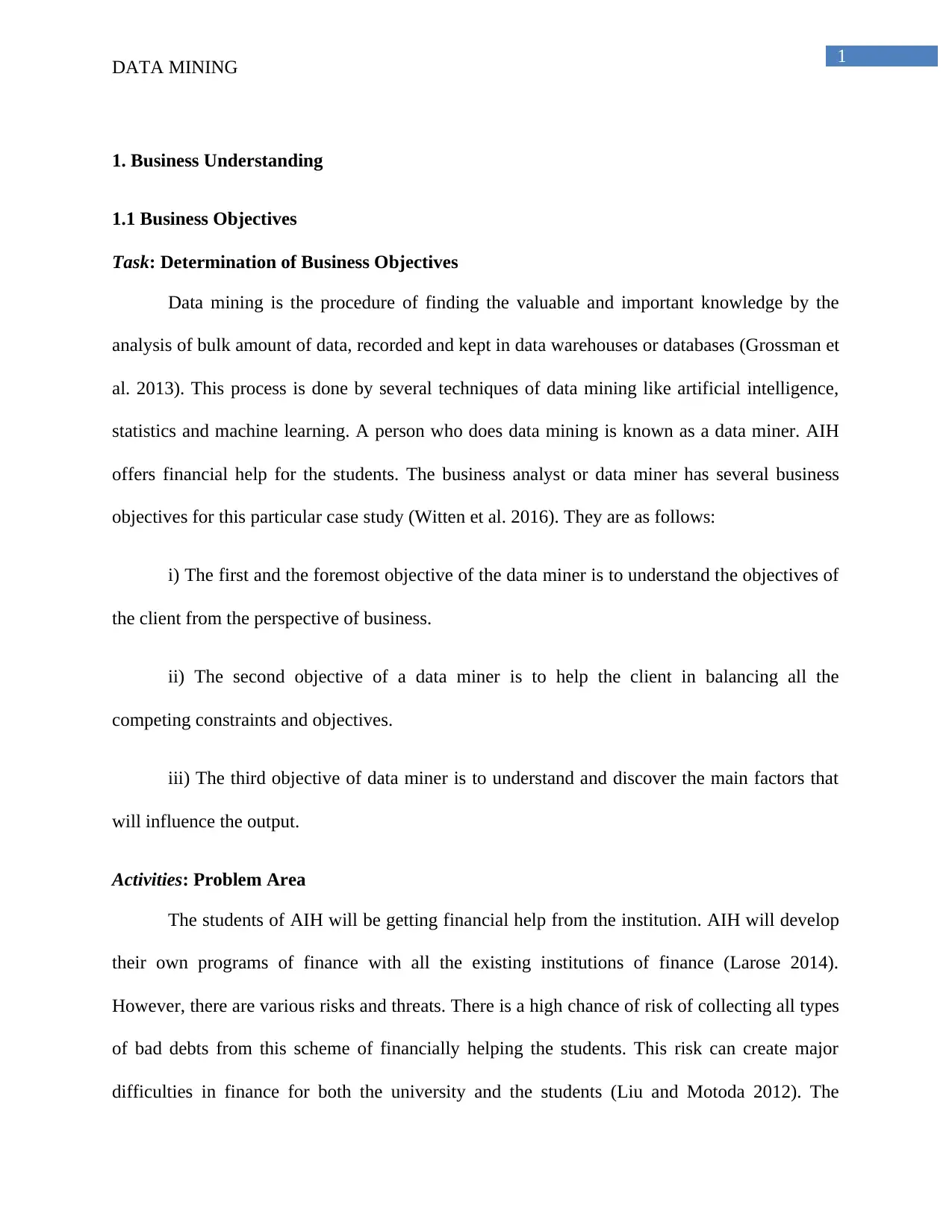
1
DATA MINING
1. Business Understanding
1.1 Business Objectives
Task: Determination of Business Objectives
Data mining is the procedure of finding the valuable and important knowledge by the
analysis of bulk amount of data, recorded and kept in data warehouses or databases (Grossman et
al. 2013). This process is done by several techniques of data mining like artificial intelligence,
statistics and machine learning. A person who does data mining is known as a data miner. AIH
offers financial help for the students. The business analyst or data miner has several business
objectives for this particular case study (Witten et al. 2016). They are as follows:
i) The first and the foremost objective of the data miner is to understand the objectives of
the client from the perspective of business.
ii) The second objective of a data miner is to help the client in balancing all the
competing constraints and objectives.
iii) The third objective of data miner is to understand and discover the main factors that
will influence the output.
Activities: Problem Area
The students of AIH will be getting financial help from the institution. AIH will develop
their own programs of finance with all the existing institutions of finance (Larose 2014).
However, there are various risks and threats. There is a high chance of risk of collecting all types
of bad debts from this scheme of financially helping the students. This risk can create major
difficulties in finance for both the university and the students (Liu and Motoda 2012). The
DATA MINING
1. Business Understanding
1.1 Business Objectives
Task: Determination of Business Objectives
Data mining is the procedure of finding the valuable and important knowledge by the
analysis of bulk amount of data, recorded and kept in data warehouses or databases (Grossman et
al. 2013). This process is done by several techniques of data mining like artificial intelligence,
statistics and machine learning. A person who does data mining is known as a data miner. AIH
offers financial help for the students. The business analyst or data miner has several business
objectives for this particular case study (Witten et al. 2016). They are as follows:
i) The first and the foremost objective of the data miner is to understand the objectives of
the client from the perspective of business.
ii) The second objective of a data miner is to help the client in balancing all the
competing constraints and objectives.
iii) The third objective of data miner is to understand and discover the main factors that
will influence the output.
Activities: Problem Area
The students of AIH will be getting financial help from the institution. AIH will develop
their own programs of finance with all the existing institutions of finance (Larose 2014).
However, there are various risks and threats. There is a high chance of risk of collecting all types
of bad debts from this scheme of financially helping the students. This risk can create major
difficulties in finance for both the university and the students (Liu and Motoda 2012). The
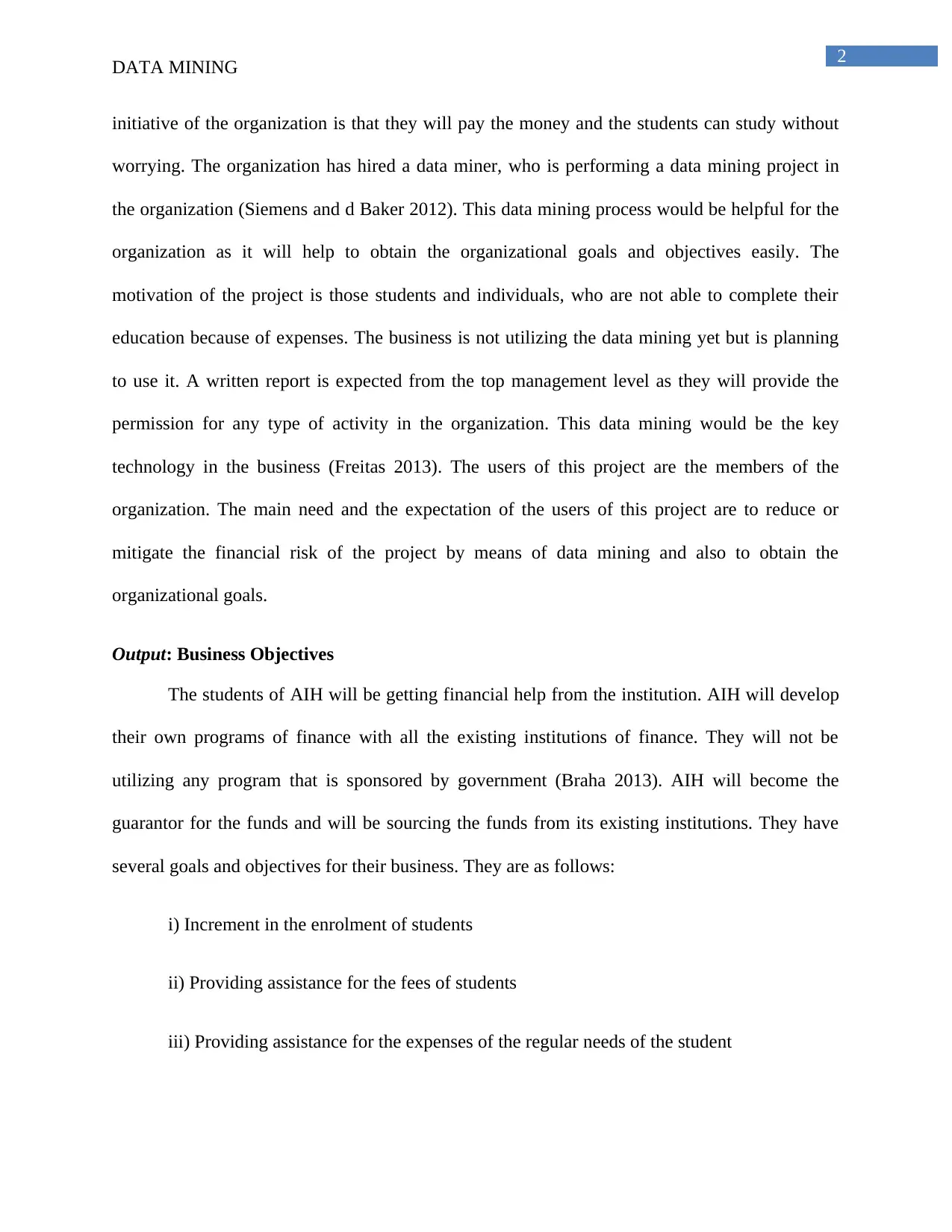
2
DATA MINING
initiative of the organization is that they will pay the money and the students can study without
worrying. The organization has hired a data miner, who is performing a data mining project in
the organization (Siemens and d Baker 2012). This data mining process would be helpful for the
organization as it will help to obtain the organizational goals and objectives easily. The
motivation of the project is those students and individuals, who are not able to complete their
education because of expenses. The business is not utilizing the data mining yet but is planning
to use it. A written report is expected from the top management level as they will provide the
permission for any type of activity in the organization. This data mining would be the key
technology in the business (Freitas 2013). The users of this project are the members of the
organization. The main need and the expectation of the users of this project are to reduce or
mitigate the financial risk of the project by means of data mining and also to obtain the
organizational goals.
Output: Business Objectives
The students of AIH will be getting financial help from the institution. AIH will develop
their own programs of finance with all the existing institutions of finance. They will not be
utilizing any program that is sponsored by government (Braha 2013). AIH will become the
guarantor for the funds and will be sourcing the funds from its existing institutions. They have
several goals and objectives for their business. They are as follows:
i) Increment in the enrolment of students
ii) Providing assistance for the fees of students
iii) Providing assistance for the expenses of the regular needs of the student
DATA MINING
initiative of the organization is that they will pay the money and the students can study without
worrying. The organization has hired a data miner, who is performing a data mining project in
the organization (Siemens and d Baker 2012). This data mining process would be helpful for the
organization as it will help to obtain the organizational goals and objectives easily. The
motivation of the project is those students and individuals, who are not able to complete their
education because of expenses. The business is not utilizing the data mining yet but is planning
to use it. A written report is expected from the top management level as they will provide the
permission for any type of activity in the organization. This data mining would be the key
technology in the business (Freitas 2013). The users of this project are the members of the
organization. The main need and the expectation of the users of this project are to reduce or
mitigate the financial risk of the project by means of data mining and also to obtain the
organizational goals.
Output: Business Objectives
The students of AIH will be getting financial help from the institution. AIH will develop
their own programs of finance with all the existing institutions of finance. They will not be
utilizing any program that is sponsored by government (Braha 2013). AIH will become the
guarantor for the funds and will be sourcing the funds from its existing institutions. They have
several goals and objectives for their business. They are as follows:
i) Increment in the enrolment of students
ii) Providing assistance for the fees of students
iii) Providing assistance for the expenses of the regular needs of the student
⊘ This is a preview!⊘
Do you want full access?
Subscribe today to unlock all pages.

Trusted by 1+ million students worldwide
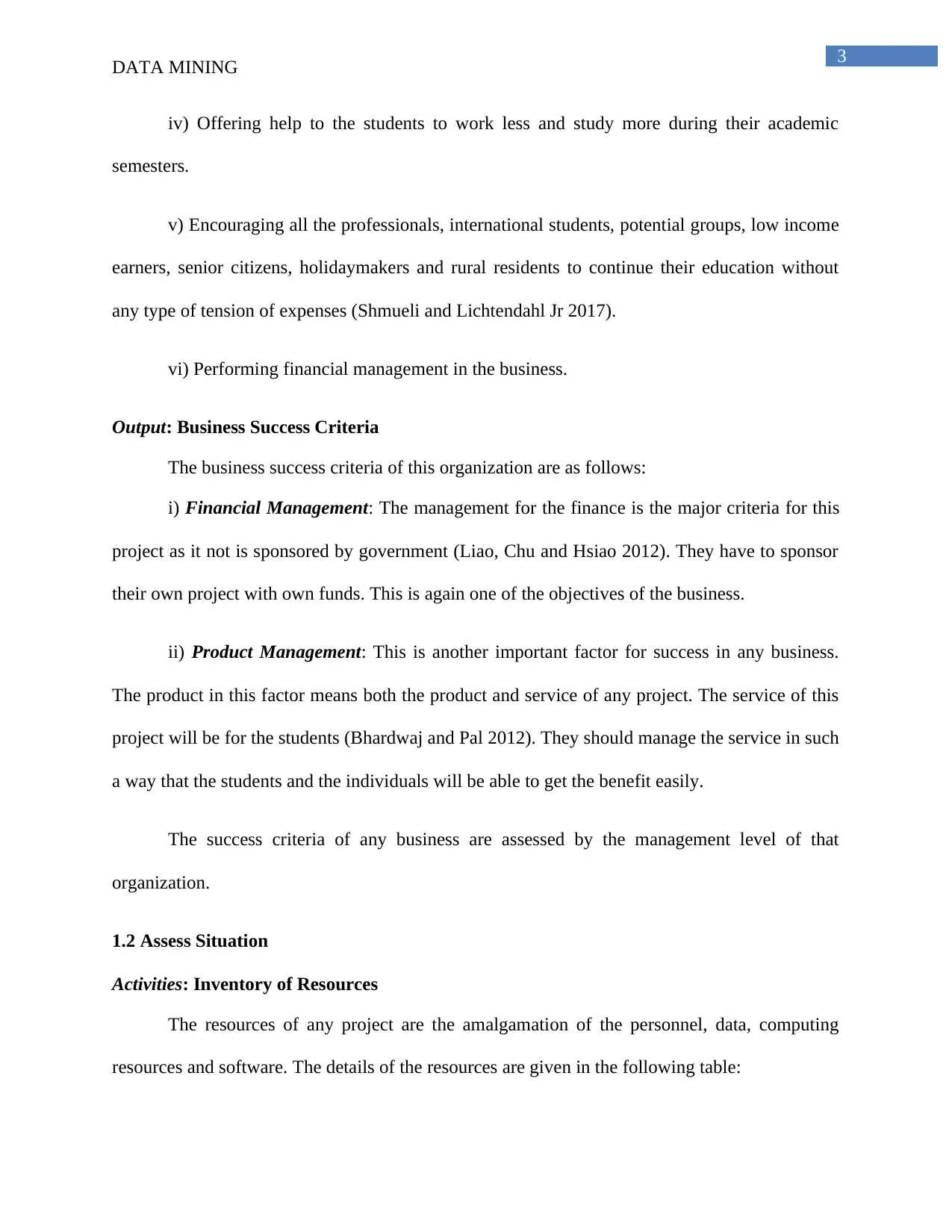
3
DATA MINING
iv) Offering help to the students to work less and study more during their academic
semesters.
v) Encouraging all the professionals, international students, potential groups, low income
earners, senior citizens, holidaymakers and rural residents to continue their education without
any type of tension of expenses (Shmueli and Lichtendahl Jr 2017).
vi) Performing financial management in the business.
Output: Business Success Criteria
The business success criteria of this organization are as follows:
i) Financial Management: The management for the finance is the major criteria for this
project as it not is sponsored by government (Liao, Chu and Hsiao 2012). They have to sponsor
their own project with own funds. This is again one of the objectives of the business.
ii) Product Management: This is another important factor for success in any business.
The product in this factor means both the product and service of any project. The service of this
project will be for the students (Bhardwaj and Pal 2012). They should manage the service in such
a way that the students and the individuals will be able to get the benefit easily.
The success criteria of any business are assessed by the management level of that
organization.
1.2 Assess Situation
Activities: Inventory of Resources
The resources of any project are the amalgamation of the personnel, data, computing
resources and software. The details of the resources are given in the following table:
DATA MINING
iv) Offering help to the students to work less and study more during their academic
semesters.
v) Encouraging all the professionals, international students, potential groups, low income
earners, senior citizens, holidaymakers and rural residents to continue their education without
any type of tension of expenses (Shmueli and Lichtendahl Jr 2017).
vi) Performing financial management in the business.
Output: Business Success Criteria
The business success criteria of this organization are as follows:
i) Financial Management: The management for the finance is the major criteria for this
project as it not is sponsored by government (Liao, Chu and Hsiao 2012). They have to sponsor
their own project with own funds. This is again one of the objectives of the business.
ii) Product Management: This is another important factor for success in any business.
The product in this factor means both the product and service of any project. The service of this
project will be for the students (Bhardwaj and Pal 2012). They should manage the service in such
a way that the students and the individuals will be able to get the benefit easily.
The success criteria of any business are assessed by the management level of that
organization.
1.2 Assess Situation
Activities: Inventory of Resources
The resources of any project are the amalgamation of the personnel, data, computing
resources and software. The details of the resources are given in the following table:
Paraphrase This Document
Need a fresh take? Get an instant paraphrase of this document with our AI Paraphraser
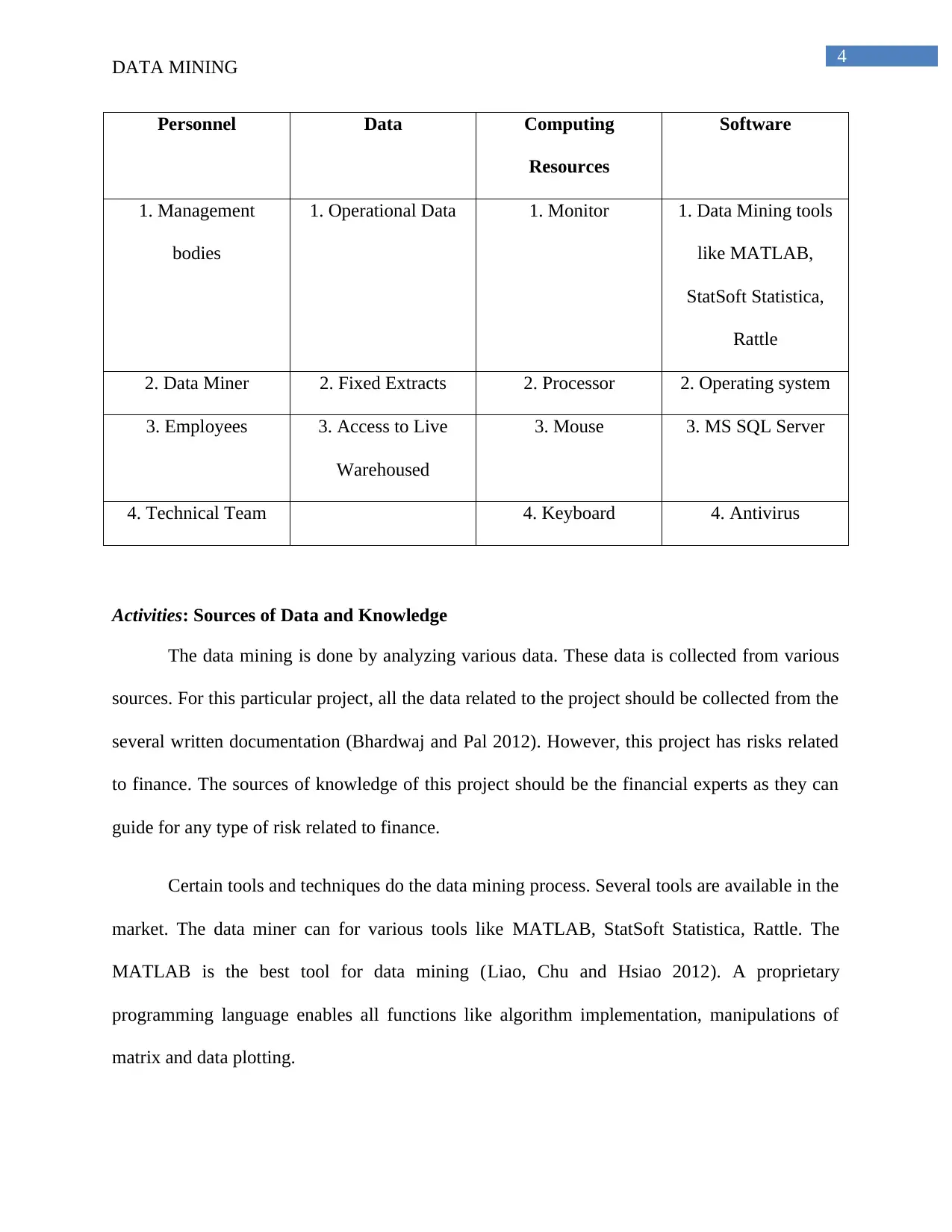
4
DATA MINING
Personnel Data Computing
Resources
Software
1. Management
bodies
1. Operational Data 1. Monitor 1. Data Mining tools
like MATLAB,
StatSoft Statistica,
Rattle
2. Data Miner 2. Fixed Extracts 2. Processor 2. Operating system
3. Employees 3. Access to Live
Warehoused
3. Mouse 3. MS SQL Server
4. Technical Team 4. Keyboard 4. Antivirus
Activities: Sources of Data and Knowledge
The data mining is done by analyzing various data. These data is collected from various
sources. For this particular project, all the data related to the project should be collected from the
several written documentation (Bhardwaj and Pal 2012). However, this project has risks related
to finance. The sources of knowledge of this project should be the financial experts as they can
guide for any type of risk related to finance.
Certain tools and techniques do the data mining process. Several tools are available in the
market. The data miner can for various tools like MATLAB, StatSoft Statistica, Rattle. The
MATLAB is the best tool for data mining (Liao, Chu and Hsiao 2012). A proprietary
programming language enables all functions like algorithm implementation, manipulations of
matrix and data plotting.
DATA MINING
Personnel Data Computing
Resources
Software
1. Management
bodies
1. Operational Data 1. Monitor 1. Data Mining tools
like MATLAB,
StatSoft Statistica,
Rattle
2. Data Miner 2. Fixed Extracts 2. Processor 2. Operating system
3. Employees 3. Access to Live
Warehoused
3. Mouse 3. MS SQL Server
4. Technical Team 4. Keyboard 4. Antivirus
Activities: Sources of Data and Knowledge
The data mining is done by analyzing various data. These data is collected from various
sources. For this particular project, all the data related to the project should be collected from the
several written documentation (Bhardwaj and Pal 2012). However, this project has risks related
to finance. The sources of knowledge of this project should be the financial experts as they can
guide for any type of risk related to finance.
Certain tools and techniques do the data mining process. Several tools are available in the
market. The data miner can for various tools like MATLAB, StatSoft Statistica, Rattle. The
MATLAB is the best tool for data mining (Liao, Chu and Hsiao 2012). A proprietary
programming language enables all functions like algorithm implementation, manipulations of
matrix and data plotting.
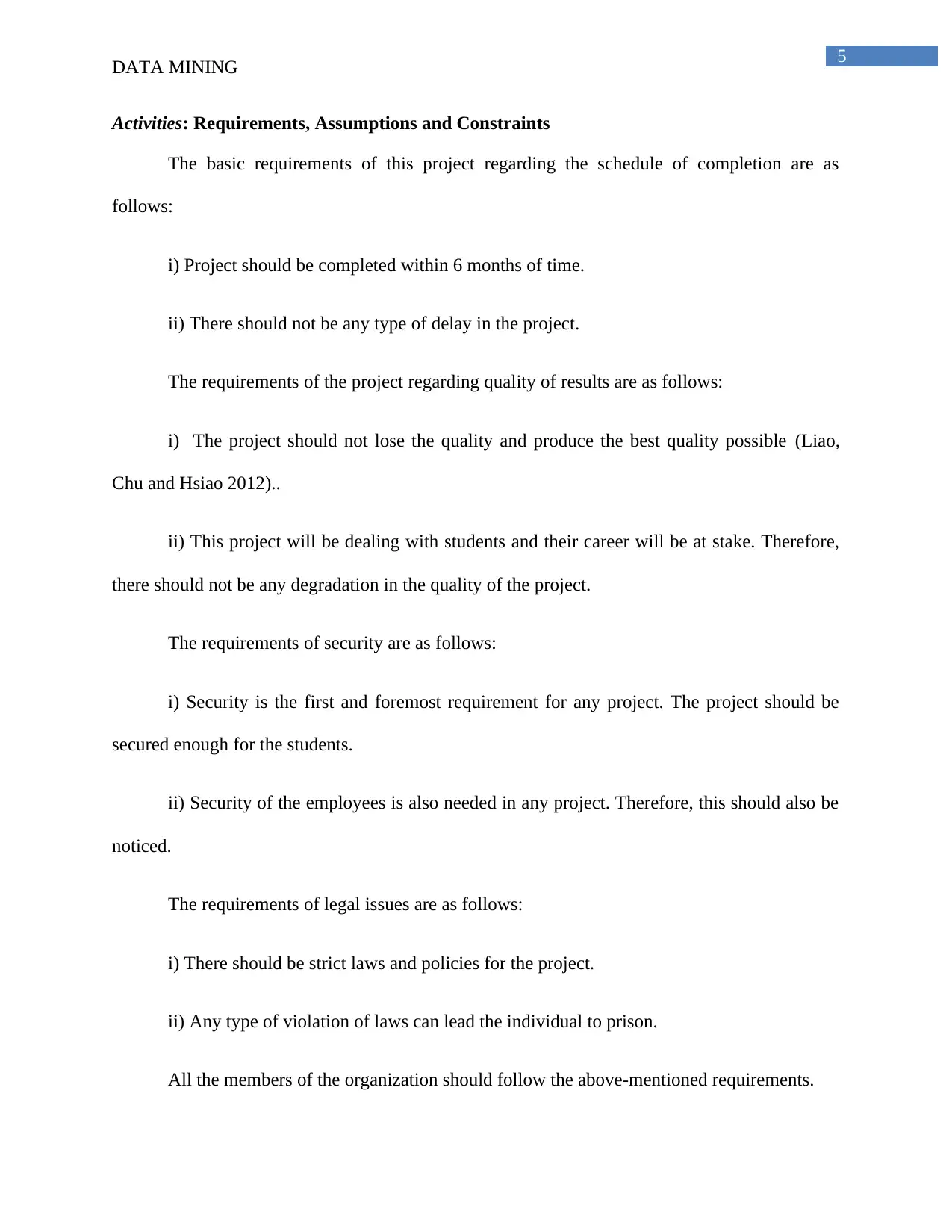
5
DATA MINING
Activities: Requirements, Assumptions and Constraints
The basic requirements of this project regarding the schedule of completion are as
follows:
i) Project should be completed within 6 months of time.
ii) There should not be any type of delay in the project.
The requirements of the project regarding quality of results are as follows:
i) The project should not lose the quality and produce the best quality possible (Liao,
Chu and Hsiao 2012)..
ii) This project will be dealing with students and their career will be at stake. Therefore,
there should not be any degradation in the quality of the project.
The requirements of security are as follows:
i) Security is the first and foremost requirement for any project. The project should be
secured enough for the students.
ii) Security of the employees is also needed in any project. Therefore, this should also be
noticed.
The requirements of legal issues are as follows:
i) There should be strict laws and policies for the project.
ii) Any type of violation of laws can lead the individual to prison.
All the members of the organization should follow the above-mentioned requirements.
DATA MINING
Activities: Requirements, Assumptions and Constraints
The basic requirements of this project regarding the schedule of completion are as
follows:
i) Project should be completed within 6 months of time.
ii) There should not be any type of delay in the project.
The requirements of the project regarding quality of results are as follows:
i) The project should not lose the quality and produce the best quality possible (Liao,
Chu and Hsiao 2012)..
ii) This project will be dealing with students and their career will be at stake. Therefore,
there should not be any degradation in the quality of the project.
The requirements of security are as follows:
i) Security is the first and foremost requirement for any project. The project should be
secured enough for the students.
ii) Security of the employees is also needed in any project. Therefore, this should also be
noticed.
The requirements of legal issues are as follows:
i) There should be strict laws and policies for the project.
ii) Any type of violation of laws can lead the individual to prison.
All the members of the organization should follow the above-mentioned requirements.
⊘ This is a preview!⊘
Do you want full access?
Subscribe today to unlock all pages.

Trusted by 1+ million students worldwide
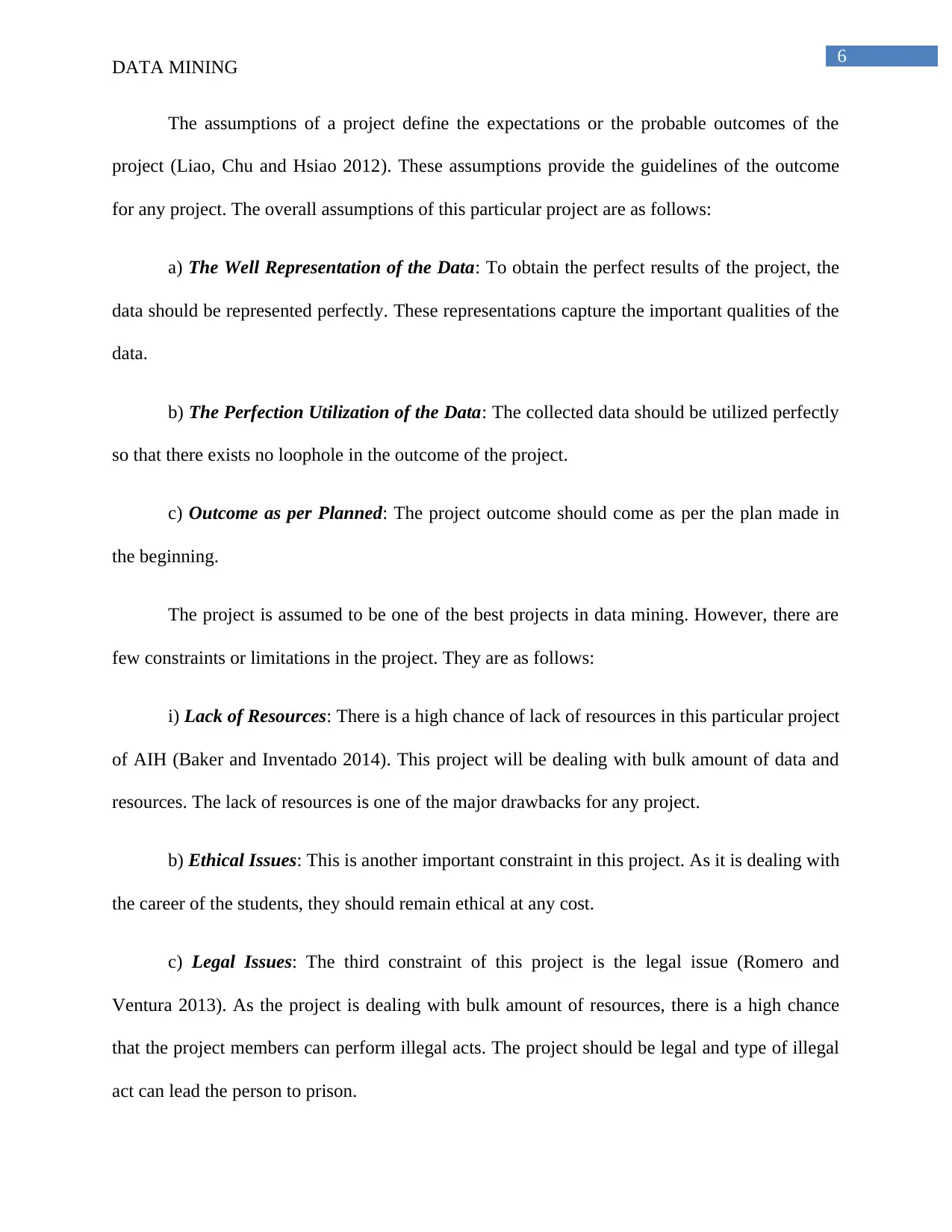
6
DATA MINING
The assumptions of a project define the expectations or the probable outcomes of the
project (Liao, Chu and Hsiao 2012). These assumptions provide the guidelines of the outcome
for any project. The overall assumptions of this particular project are as follows:
a) The Well Representation of the Data: To obtain the perfect results of the project, the
data should be represented perfectly. These representations capture the important qualities of the
data.
b) The Perfection Utilization of the Data: The collected data should be utilized perfectly
so that there exists no loophole in the outcome of the project.
c) Outcome as per Planned: The project outcome should come as per the plan made in
the beginning.
The project is assumed to be one of the best projects in data mining. However, there are
few constraints or limitations in the project. They are as follows:
i) Lack of Resources: There is a high chance of lack of resources in this particular project
of AIH (Baker and Inventado 2014). This project will be dealing with bulk amount of data and
resources. The lack of resources is one of the major drawbacks for any project.
b) Ethical Issues: This is another important constraint in this project. As it is dealing with
the career of the students, they should remain ethical at any cost.
c) Legal Issues: The third constraint of this project is the legal issue (Romero and
Ventura 2013). As the project is dealing with bulk amount of resources, there is a high chance
that the project members can perform illegal acts. The project should be legal and type of illegal
act can lead the person to prison.
DATA MINING
The assumptions of a project define the expectations or the probable outcomes of the
project (Liao, Chu and Hsiao 2012). These assumptions provide the guidelines of the outcome
for any project. The overall assumptions of this particular project are as follows:
a) The Well Representation of the Data: To obtain the perfect results of the project, the
data should be represented perfectly. These representations capture the important qualities of the
data.
b) The Perfection Utilization of the Data: The collected data should be utilized perfectly
so that there exists no loophole in the outcome of the project.
c) Outcome as per Planned: The project outcome should come as per the plan made in
the beginning.
The project is assumed to be one of the best projects in data mining. However, there are
few constraints or limitations in the project. They are as follows:
i) Lack of Resources: There is a high chance of lack of resources in this particular project
of AIH (Baker and Inventado 2014). This project will be dealing with bulk amount of data and
resources. The lack of resources is one of the major drawbacks for any project.
b) Ethical Issues: This is another important constraint in this project. As it is dealing with
the career of the students, they should remain ethical at any cost.
c) Legal Issues: The third constraint of this project is the legal issue (Romero and
Ventura 2013). As the project is dealing with bulk amount of resources, there is a high chance
that the project members can perform illegal acts. The project should be legal and type of illegal
act can lead the person to prison.
Paraphrase This Document
Need a fresh take? Get an instant paraphrase of this document with our AI Paraphraser
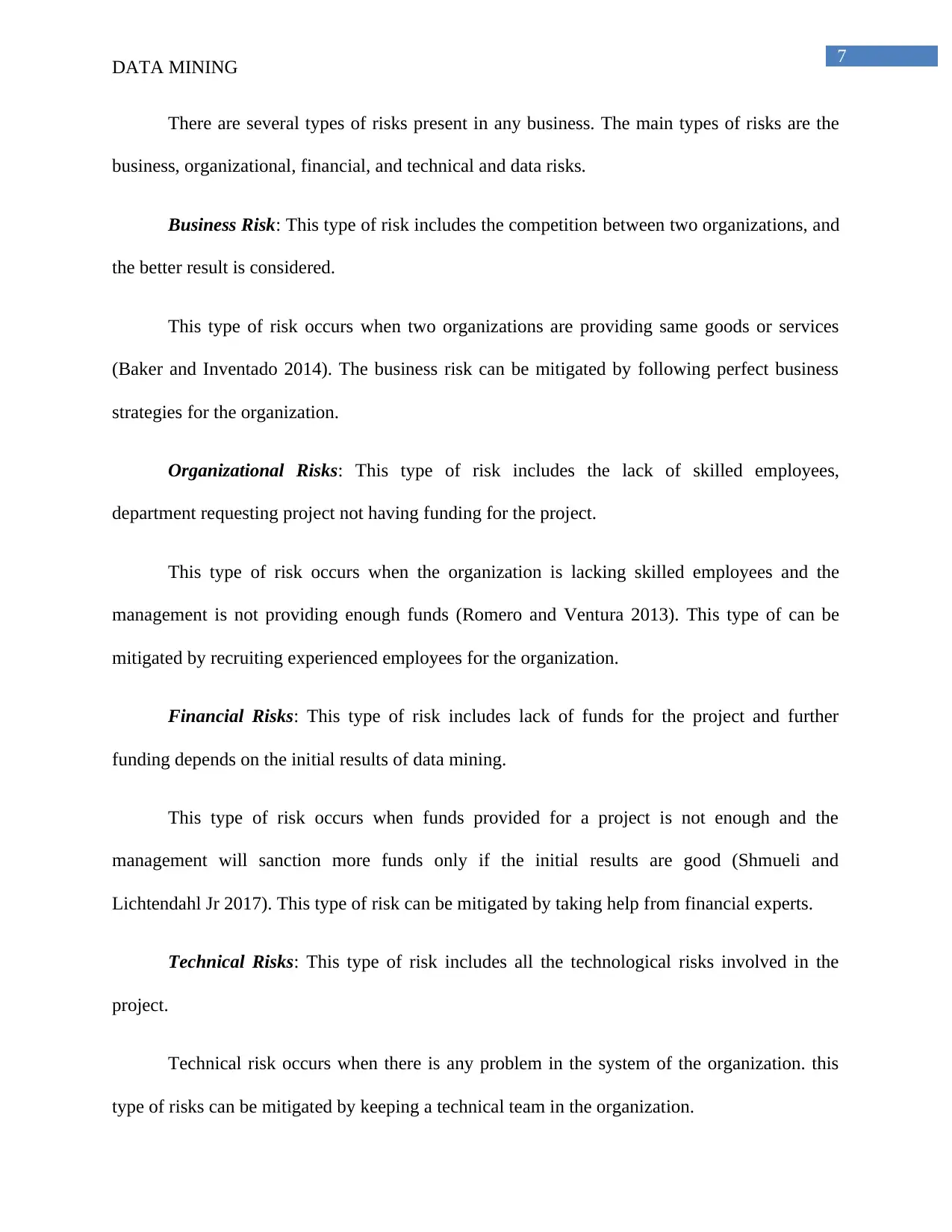
7
DATA MINING
There are several types of risks present in any business. The main types of risks are the
business, organizational, financial, and technical and data risks.
Business Risk: This type of risk includes the competition between two organizations, and
the better result is considered.
This type of risk occurs when two organizations are providing same goods or services
(Baker and Inventado 2014). The business risk can be mitigated by following perfect business
strategies for the organization.
Organizational Risks: This type of risk includes the lack of skilled employees,
department requesting project not having funding for the project.
This type of risk occurs when the organization is lacking skilled employees and the
management is not providing enough funds (Romero and Ventura 2013). This type of can be
mitigated by recruiting experienced employees for the organization.
Financial Risks: This type of risk includes lack of funds for the project and further
funding depends on the initial results of data mining.
This type of risk occurs when funds provided for a project is not enough and the
management will sanction more funds only if the initial results are good (Shmueli and
Lichtendahl Jr 2017). This type of risk can be mitigated by taking help from financial experts.
Technical Risks: This type of risk includes all the technological risks involved in the
project.
Technical risk occurs when there is any problem in the system of the organization. this
type of risks can be mitigated by keeping a technical team in the organization.
DATA MINING
There are several types of risks present in any business. The main types of risks are the
business, organizational, financial, and technical and data risks.
Business Risk: This type of risk includes the competition between two organizations, and
the better result is considered.
This type of risk occurs when two organizations are providing same goods or services
(Baker and Inventado 2014). The business risk can be mitigated by following perfect business
strategies for the organization.
Organizational Risks: This type of risk includes the lack of skilled employees,
department requesting project not having funding for the project.
This type of risk occurs when the organization is lacking skilled employees and the
management is not providing enough funds (Romero and Ventura 2013). This type of can be
mitigated by recruiting experienced employees for the organization.
Financial Risks: This type of risk includes lack of funds for the project and further
funding depends on the initial results of data mining.
This type of risk occurs when funds provided for a project is not enough and the
management will sanction more funds only if the initial results are good (Shmueli and
Lichtendahl Jr 2017). This type of risk can be mitigated by taking help from financial experts.
Technical Risks: This type of risk includes all the technological risks involved in the
project.
Technical risk occurs when there is any problem in the system of the organization. this
type of risks can be mitigated by keeping a technical team in the organization.
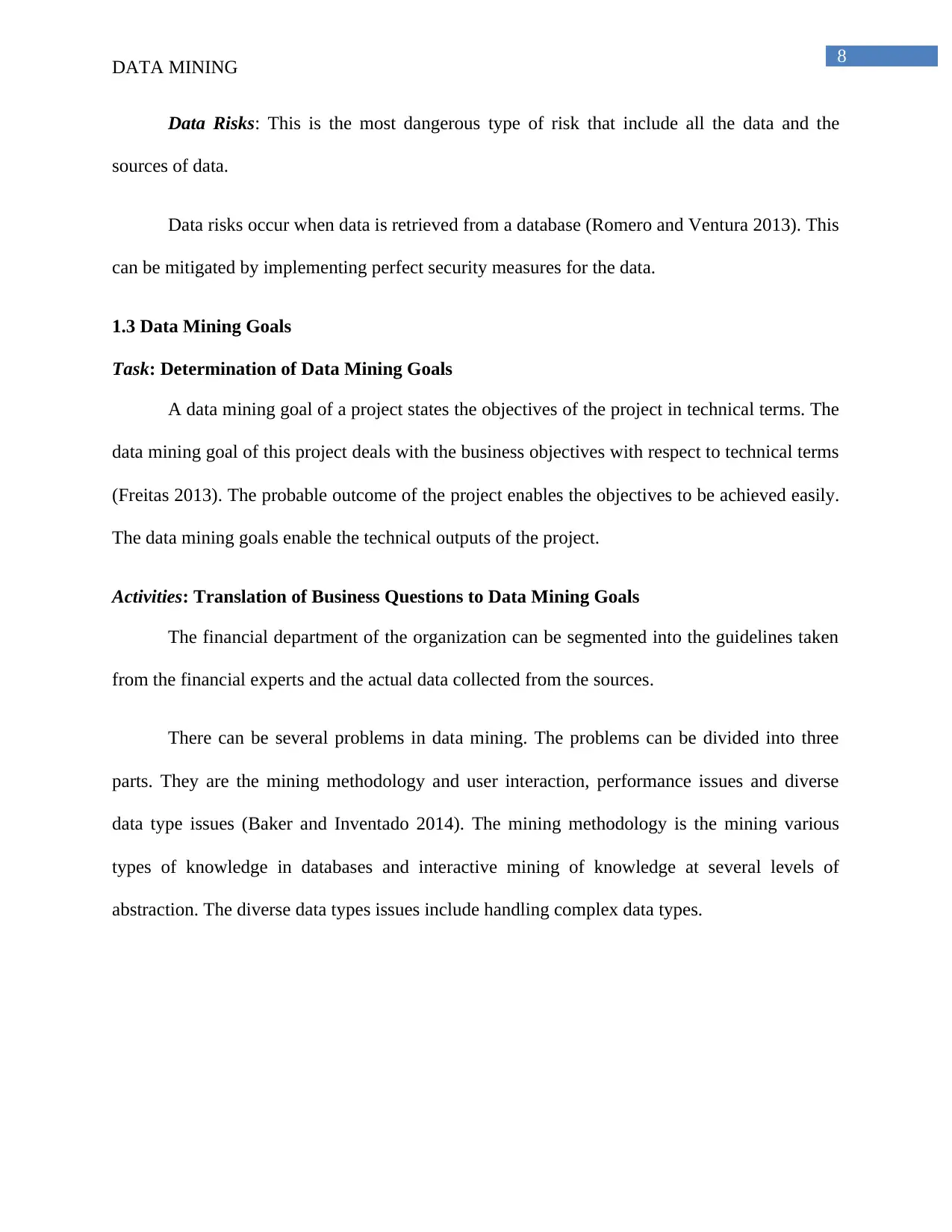
8
DATA MINING
Data Risks: This is the most dangerous type of risk that include all the data and the
sources of data.
Data risks occur when data is retrieved from a database (Romero and Ventura 2013). This
can be mitigated by implementing perfect security measures for the data.
1.3 Data Mining Goals
Task: Determination of Data Mining Goals
A data mining goal of a project states the objectives of the project in technical terms. The
data mining goal of this project deals with the business objectives with respect to technical terms
(Freitas 2013). The probable outcome of the project enables the objectives to be achieved easily.
The data mining goals enable the technical outputs of the project.
Activities: Translation of Business Questions to Data Mining Goals
The financial department of the organization can be segmented into the guidelines taken
from the financial experts and the actual data collected from the sources.
There can be several problems in data mining. The problems can be divided into three
parts. They are the mining methodology and user interaction, performance issues and diverse
data type issues (Baker and Inventado 2014). The mining methodology is the mining various
types of knowledge in databases and interactive mining of knowledge at several levels of
abstraction. The diverse data types issues include handling complex data types.
DATA MINING
Data Risks: This is the most dangerous type of risk that include all the data and the
sources of data.
Data risks occur when data is retrieved from a database (Romero and Ventura 2013). This
can be mitigated by implementing perfect security measures for the data.
1.3 Data Mining Goals
Task: Determination of Data Mining Goals
A data mining goal of a project states the objectives of the project in technical terms. The
data mining goal of this project deals with the business objectives with respect to technical terms
(Freitas 2013). The probable outcome of the project enables the objectives to be achieved easily.
The data mining goals enable the technical outputs of the project.
Activities: Translation of Business Questions to Data Mining Goals
The financial department of the organization can be segmented into the guidelines taken
from the financial experts and the actual data collected from the sources.
There can be several problems in data mining. The problems can be divided into three
parts. They are the mining methodology and user interaction, performance issues and diverse
data type issues (Baker and Inventado 2014). The mining methodology is the mining various
types of knowledge in databases and interactive mining of knowledge at several levels of
abstraction. The diverse data types issues include handling complex data types.
⊘ This is a preview!⊘
Do you want full access?
Subscribe today to unlock all pages.

Trusted by 1+ million students worldwide
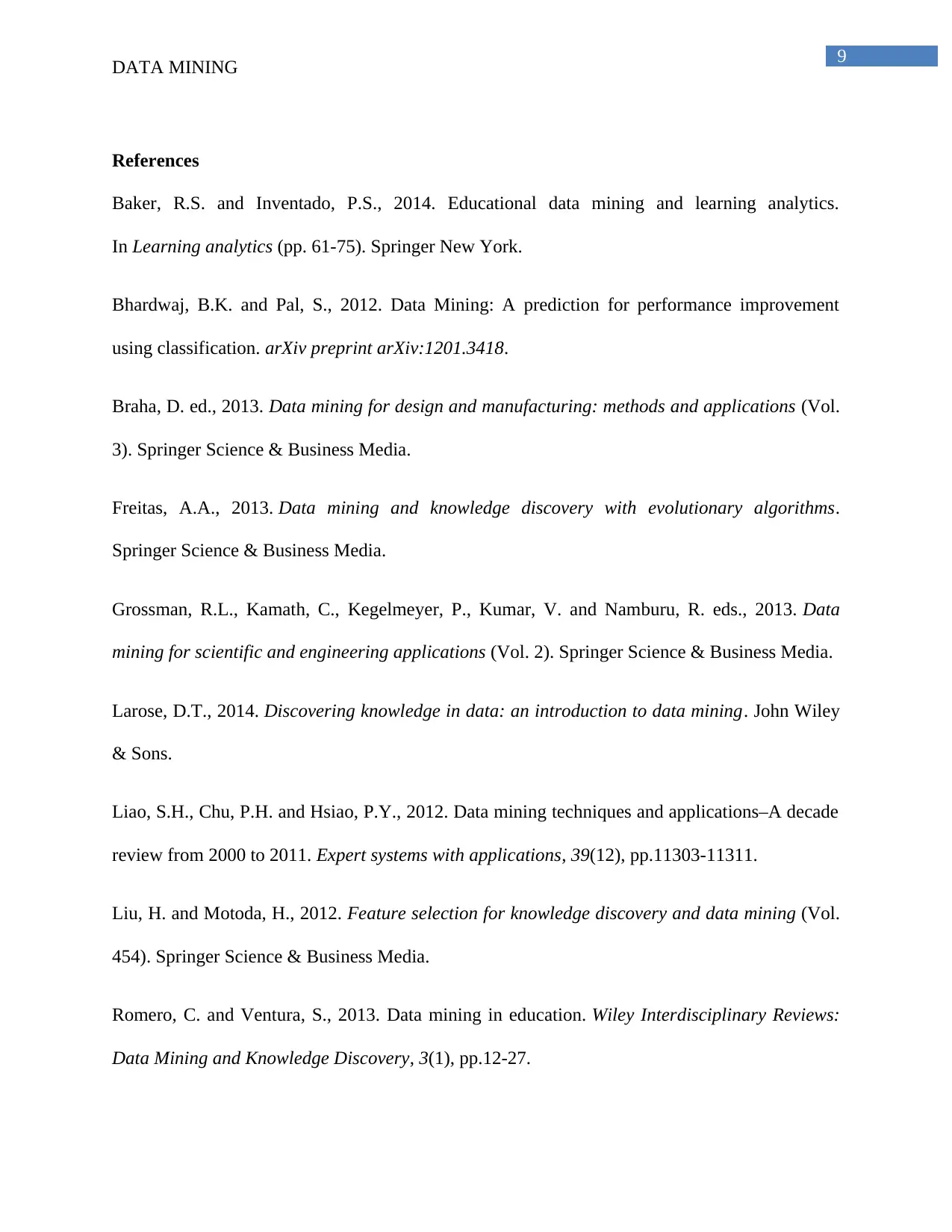
9
DATA MINING
References
Baker, R.S. and Inventado, P.S., 2014. Educational data mining and learning analytics.
In Learning analytics (pp. 61-75). Springer New York.
Bhardwaj, B.K. and Pal, S., 2012. Data Mining: A prediction for performance improvement
using classification. arXiv preprint arXiv:1201.3418.
Braha, D. ed., 2013. Data mining for design and manufacturing: methods and applications (Vol.
3). Springer Science & Business Media.
Freitas, A.A., 2013. Data mining and knowledge discovery with evolutionary algorithms.
Springer Science & Business Media.
Grossman, R.L., Kamath, C., Kegelmeyer, P., Kumar, V. and Namburu, R. eds., 2013. Data
mining for scientific and engineering applications (Vol. 2). Springer Science & Business Media.
Larose, D.T., 2014. Discovering knowledge in data: an introduction to data mining. John Wiley
& Sons.
Liao, S.H., Chu, P.H. and Hsiao, P.Y., 2012. Data mining techniques and applications–A decade
review from 2000 to 2011. Expert systems with applications, 39(12), pp.11303-11311.
Liu, H. and Motoda, H., 2012. Feature selection for knowledge discovery and data mining (Vol.
454). Springer Science & Business Media.
Romero, C. and Ventura, S., 2013. Data mining in education. Wiley Interdisciplinary Reviews:
Data Mining and Knowledge Discovery, 3(1), pp.12-27.
DATA MINING
References
Baker, R.S. and Inventado, P.S., 2014. Educational data mining and learning analytics.
In Learning analytics (pp. 61-75). Springer New York.
Bhardwaj, B.K. and Pal, S., 2012. Data Mining: A prediction for performance improvement
using classification. arXiv preprint arXiv:1201.3418.
Braha, D. ed., 2013. Data mining for design and manufacturing: methods and applications (Vol.
3). Springer Science & Business Media.
Freitas, A.A., 2013. Data mining and knowledge discovery with evolutionary algorithms.
Springer Science & Business Media.
Grossman, R.L., Kamath, C., Kegelmeyer, P., Kumar, V. and Namburu, R. eds., 2013. Data
mining for scientific and engineering applications (Vol. 2). Springer Science & Business Media.
Larose, D.T., 2014. Discovering knowledge in data: an introduction to data mining. John Wiley
& Sons.
Liao, S.H., Chu, P.H. and Hsiao, P.Y., 2012. Data mining techniques and applications–A decade
review from 2000 to 2011. Expert systems with applications, 39(12), pp.11303-11311.
Liu, H. and Motoda, H., 2012. Feature selection for knowledge discovery and data mining (Vol.
454). Springer Science & Business Media.
Romero, C. and Ventura, S., 2013. Data mining in education. Wiley Interdisciplinary Reviews:
Data Mining and Knowledge Discovery, 3(1), pp.12-27.
Paraphrase This Document
Need a fresh take? Get an instant paraphrase of this document with our AI Paraphraser
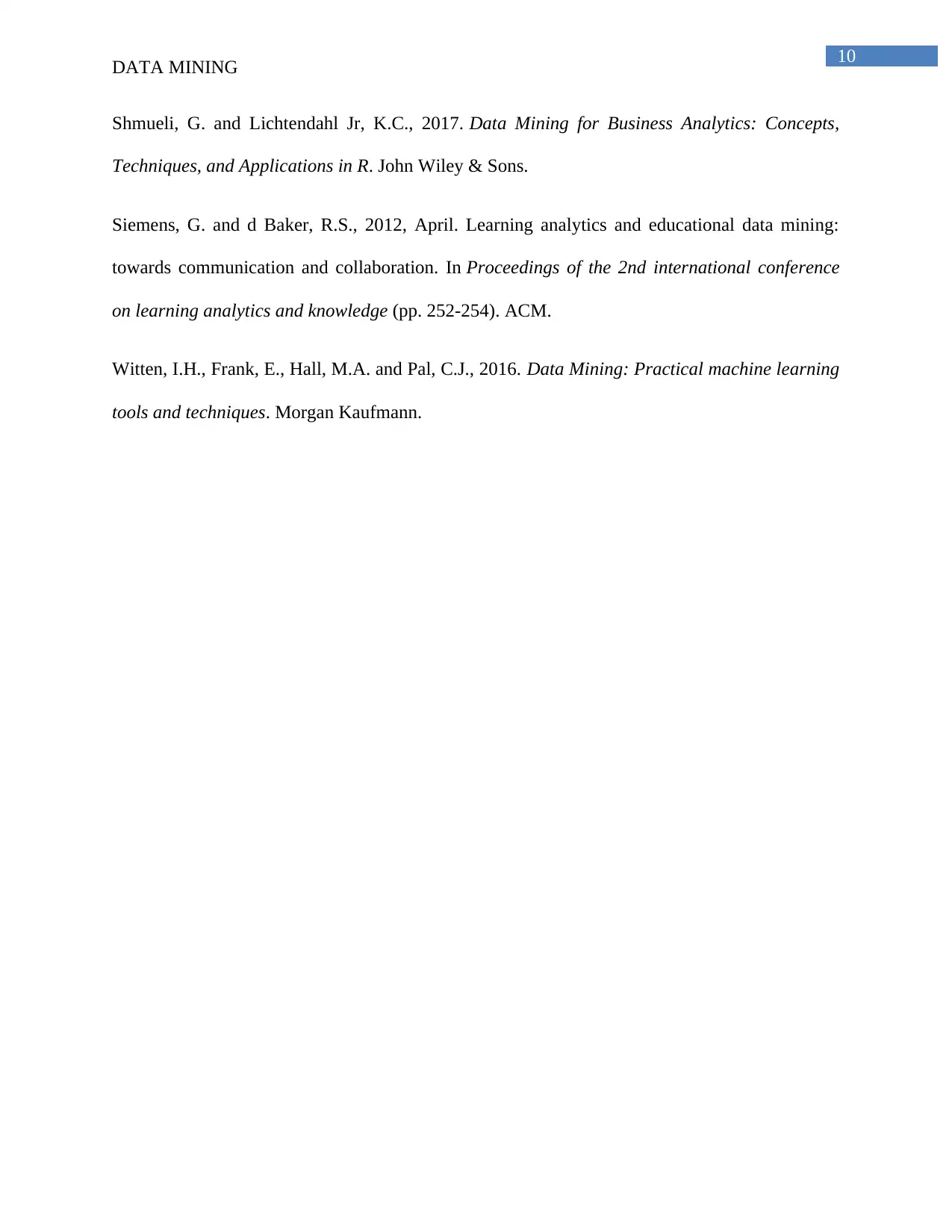
10
DATA MINING
Shmueli, G. and Lichtendahl Jr, K.C., 2017. Data Mining for Business Analytics: Concepts,
Techniques, and Applications in R. John Wiley & Sons.
Siemens, G. and d Baker, R.S., 2012, April. Learning analytics and educational data mining:
towards communication and collaboration. In Proceedings of the 2nd international conference
on learning analytics and knowledge (pp. 252-254). ACM.
Witten, I.H., Frank, E., Hall, M.A. and Pal, C.J., 2016. Data Mining: Practical machine learning
tools and techniques. Morgan Kaufmann.
DATA MINING
Shmueli, G. and Lichtendahl Jr, K.C., 2017. Data Mining for Business Analytics: Concepts,
Techniques, and Applications in R. John Wiley & Sons.
Siemens, G. and d Baker, R.S., 2012, April. Learning analytics and educational data mining:
towards communication and collaboration. In Proceedings of the 2nd international conference
on learning analytics and knowledge (pp. 252-254). ACM.
Witten, I.H., Frank, E., Hall, M.A. and Pal, C.J., 2016. Data Mining: Practical machine learning
tools and techniques. Morgan Kaufmann.
1 out of 11
Related Documents
Your All-in-One AI-Powered Toolkit for Academic Success.
+13062052269
info@desklib.com
Available 24*7 on WhatsApp / Email
![[object Object]](/_next/static/media/star-bottom.7253800d.svg)
Unlock your academic potential
Copyright © 2020–2025 A2Z Services. All Rights Reserved. Developed and managed by ZUCOL.





